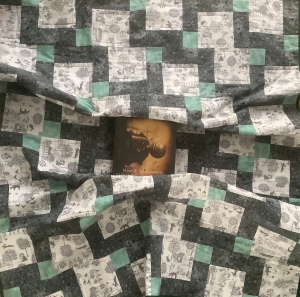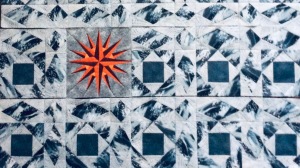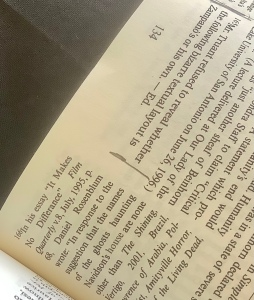The Sot-Weed Factor
Part Two of my real-time review of THE SOT-WEED FACTOR by John Barth, a review that will evolve in the comment stream below as I read it…
Continued from Part One here: https://dflewisreviews.wordpress.com/2021/02/17/the-sot-weed-factor-john-barth/




 Pages 133 – 152
Pages 133 – 152
Part II
5
HB continues telling his story to E, his adventures in Maryland and elsewhere in New England and the politics involved, papal or not, not papacy so much as piracy , and his searching for his Burlingame heritage, a telling that became almost as boring as an earlier history in this book that E had equally punctuated with his ejaculations, but perhaps sometimes less boring if more reprehensibly cruel (as shown in example above) with his tales of his seeing, even partaking in, acts of swiving and rogering, whereby machinations of both distaff and spear were obliquely bartered as E had once done with Toast, a couple of French women, mother and daughter, though, being quite cute with their talk and false leadings-on….
The next chapter looks as if it might be more of the same. ;(
6 & 7
Some rare stuff here, an unfinished manuscript history by an earlier Burlingame that HBIII discovered and has received as a clue to his heritage in the New World whither they are now going, a history of which this is a controversial extract…
And some youthful philosophy from E about the separate falls of innocence and of pride, Adam/Eve and Satan respectively, …
… virtues, ‘plain’ and ‘significant’, and his conviction, however nonsensical, that his own Virginity is significant.
I think!!
And more history from HBIII that I skipped over, as neither plain nor significant!
Perhaps this book is not so great as I recall it, after all!
Yet this part resonated with me…
8 & 9
“So saying he led the way across the street from the wharves to a tavern advertising itself by two capital letter Cs, face to face and interlocking, the figure surmounted by a three-lobed crown.
‘Here’s the King o’ the Seas,’ said Burlingame.”
…almost in spirit with Ebenezer’s own later adopted Laureate-Poet signature in these chapters, a signature of his wondrous poems-to-be that he now starts setting out in his notebook ledger originally intended for a stationer’s debit and credit columns: viz. the signature being “E.C., Gent, Pt & Lt of Md“… and he even starts a poem about the ship Poseidon he has not yet seen, let alone even embarked upon!
Meanwhile…
“‘Twas a woman wiped thy bum at birth and another shall in dotage; what matter if one do’t in between?”
These are hilarious moments compensating for the boredom in one or two of the previous chapters! Ebenezer, being affrighted by two pirates associated with some devilish historical inscrutable called Coode mentioned in the earlier boring chapters, these characters being in some complicated plot against E and HB, as the latter two wait for the shallop to take them to the moored ship Poseidon that will take them in turn to Md…so affrighted that E beshat his breeches and there is much machination to get them clean afore he tore out one or two blank pages from his notebook ledger designed for poesy, to use as bum paper, I think! Much change of rôle shenanigans also until HB appears again out of the blue — which he often seems to do!
Along with named philosophers galore being mentioned, in the interim.
Yet the highlight for me of these two chapters is the explicit contention that Literature exceeds all those Philosophers galore, Literature being the wisest, most preternatural power to guide all of life’s spiritualities and physicalities!! As I will prove with my eventual gestalt of this very book and with my other real-time empirical critiques of Literature over the years…
Cf the two Cs face to face embedded earlier here….
Cross-referenced to the explicitly mentioned ‘boredom’ or ‘ennui’ in the Danielewski book here: https://elizabethbowensite.wordpress.com/580-2/#comment-1204
10 & 11
…which sanctity of selfhood on E’s part makes an interesting foil for the surrounding shenanigans of self as someone else, amid many imposters galore, and forgeries, amid concupiscent plots of polling and furrowing, as well as more political furcating…. as E finally boards the Poseidon (the ship in the fleet at Plymouth that he must board before any other as he has already written a poem about it!), boards it disguised as his own servant, and then told by the real servant masquerading as him about some innuendo witnessed between his sister Anna and HB!!! All above my head of course, but by comic restoration osmosis it has no doubt pervaded — and seeped into — my mental sump. To be harvested for serious morals and spiritualities, one day, I hope.
“Tales are like tarts, that may be ugly on the face of ‘em and yet have a worthwhile end.”
12
“To ask a man what he thinks of gambling is as much as to ask him what he thinks of life,…”
Much gambling by those on board to while away “ennui”*, gambling at the Captain-measured distance sailed each day, with much hedging of bets and other complexities of gambling, techniques that seem to parallel later in this chapter the bluffs and double bluffs and counter-bluffs of gentleman versus poet versus servant on the “ladder of wit” and other perceived pecking-orders. The latter ricochets of thought or philosophy is spiced by our view of Ebenezer masquerading. as his own valet Bertrand, and B as his own master E and the verbal trickeries that is thus pleasantly generated under the gaze of an “excellently breasted” woman who is perhaps a whore in disguise on board the ship but who reminds E of his own earlier self-honourings regarding Joan Toast. A naïveté that is here explored nicely. A poet as half a god, half a travelling clown? And many other unforgettably witty combative exchanges between E and B….with easeful paradoxes and quick neat turnings of phrase into their opposites. The masks of what one is and of what one wants to be as well as masks against the plagues of humanity, I guess. Or as E maintains…
“The gentleman valet and the gentleman poet have this is common, that their gentlemanliness is for each a mask. But the mask of the valet masks a varlet, while the poet’s masks a god!”
*interesting, preternaturally synchronous take-up of what I was saying earlier above about the nature of boringness?
13
“He could write no verse: even the sight of great whales, which in happier times would have set his fancy spinning, now called forth not a single rhyme.”
Relevant today: https://dflewisreviews.wordpress.com/2021/03/03/i-thus-hope-i-am/
Quoted from Part One of this ongoing review.
14
“I vowed to fling myself into the arms of Life, and what is life but the taking of sides?”
Ebenezer, and thus this early Barth in 1960, seems here to be prefiguring a world of Twitting and Face-booking!
Other than that, this chapter is a farrago of Papacy and Piracy, Coode and Pound, Maryland to be Romanized or not, which the ledger, which the most precious Journal, who imports the Laureate — switching ships for whatever berths or motives of self and non-self, valet and master vying to become the other depending on the direction of the wind and the treacheries involved. Even “adolescent” wenches in nightdresses being shouldered off by sex-starved seamen… Could make no head or tail of it all. But little matter, with reading and roistering not a million miles apart!
15
“: every one of the passengers he could see was female.
‘Dear Heav’n!’ he breathed.”
Surely, there is no other substantive chapter such as this one in the whole of literature! And, if so how could I possibly have forgotten it, even from the time distance of when I must have read it some 50 plus years ago! The great debauch, the taking over of a whore ship, by an attacking force of sex-starved pirates. I must have blocked it from my mind, duly diminished by the unquestioned shame of having read its shockingly powerful reprehensibility of a sex panorama. Yet, more minutely, I can indeed question that shame today, inasmuch as it has a vital effect on Ebenezer vis à vis his own purity of virginity and the thoughts now running through his mind, including a concupiscent lust that he tries to resist, and comparing his earlier rite of passage with Joan Toast, comparing it with the Moor in red headgear raping a woman in the mast’s rigging like a black spider upon its enwebbed prey, and the constructive and complex paradoxes of thought that emerged inside Ebenezer from sight of the event, and the mixed motives of amoral morals in life itself. A revelation. A walking of the spiritual plank, as well as eventually a real one? A self-ravishment.
Mixed in with this unparalleled, brilliantly written and painfully felt vision are more plot machinations and intrigues and conspiracies, involving a secret manuscript that Ebenezer manages to steal and hide, most of which I found boring, but mentioning the name Burlingame in the light of the latter seeking the source of his heritage.
“— the centuries rang and echoed with their cries; the dirt of the planet was watered with their tears!”
16
“— he had been fascinated by the aspect of death. […] In the night, between their bed-chambers, he and his sister had examined every form of death they knew…”
Now E, dunked by plank mid-Ocean speculates on the held-breath experiments he and his sister used to mimic death by drowning. This is strong stuff. And Bertrand, now pointless whether master or servant, floats near… and if I tell you what comes up underfoot in the undertow that would spoil the plot. So read on in my review, at your own peril at the prospect of this book’s death, instead of yours! They reach what they hope is a Golden land, a Shangri-La, where they discover tied up and evidentially tortured in the past a politically incorrect “Negro”. Toe now grown to knee, we are able to be grown-up ourselves about all this and how time changes everything, and about what Bertrand, once in the Ebenezer role, now says he had earlier gambled away before being planked!
Gambled away Malden itself! A spoiler-moiler beyond our caring. We know all will work out in the end. Even death itself! That’s the truth fiction leaves in the path of sand as footprints, I guess. Behind and before.
This review will now continue here: https://elizabethbowensite.wordpress.com/612-2/